+ Open data
Open data
- Basic information
Basic information
| Entry | Database: PDB / ID: 5czi | ||||||
|---|---|---|---|---|---|---|---|
| Title | EGFR L858R MUTANT IN COMPLEX WITH A SHC PEPTIDE SUBSTRATE | ||||||
 Components Components |
| ||||||
 Keywords Keywords |  TRANSFERASE / EGFR / L858R / TRANSFERASE / EGFR / L858R /  KINASE / EGF KINASE / EGF | ||||||
| Function / homology |  Function and homology information Function and homology informationregulation of superoxide metabolic process / positive regulation of cell proliferation in bone marrow / XBP1(S) activates chaperone genes / neurotrophin TRKA receptor binding /  transmembrane receptor protein tyrosine kinase adaptor activity / Interleukin-15 signaling / response to hydroxyisoflavone / transmembrane receptor protein tyrosine kinase adaptor activity / Interleukin-15 signaling / response to hydroxyisoflavone /  multivesicular body, internal vesicle lumen / positive regulation of prolactin secretion / negative regulation of cardiocyte differentiation ...regulation of superoxide metabolic process / positive regulation of cell proliferation in bone marrow / XBP1(S) activates chaperone genes / neurotrophin TRKA receptor binding / multivesicular body, internal vesicle lumen / positive regulation of prolactin secretion / negative regulation of cardiocyte differentiation ...regulation of superoxide metabolic process / positive regulation of cell proliferation in bone marrow / XBP1(S) activates chaperone genes / neurotrophin TRKA receptor binding /  transmembrane receptor protein tyrosine kinase adaptor activity / Interleukin-15 signaling / response to hydroxyisoflavone / transmembrane receptor protein tyrosine kinase adaptor activity / Interleukin-15 signaling / response to hydroxyisoflavone /  multivesicular body, internal vesicle lumen / positive regulation of prolactin secretion / negative regulation of cardiocyte differentiation / positive regulation of protein kinase C activity / diterpenoid metabolic process / Shc-EGFR complex / Interleukin-2 signaling / multivesicular body, internal vesicle lumen / positive regulation of prolactin secretion / negative regulation of cardiocyte differentiation / positive regulation of protein kinase C activity / diterpenoid metabolic process / Shc-EGFR complex / Interleukin-2 signaling /  ovulation cycle / Inhibition of Signaling by Overexpressed EGFR / ovulation cycle / Inhibition of Signaling by Overexpressed EGFR /  epidermal growth factor receptor activity / EGFR interacts with phospholipase C-gamma / positive regulation of mucus secretion / response to UV-A / epidermal growth factor receptor activity / EGFR interacts with phospholipase C-gamma / positive regulation of mucus secretion / response to UV-A /  epidermal growth factor binding / PLCG1 events in ERBB2 signaling / tongue development / midgut development / ERBB2-EGFR signaling pathway / hydrogen peroxide metabolic process / PTK6 promotes HIF1A stabilization / digestive tract morphogenesis / epidermal growth factor binding / PLCG1 events in ERBB2 signaling / tongue development / midgut development / ERBB2-EGFR signaling pathway / hydrogen peroxide metabolic process / PTK6 promotes HIF1A stabilization / digestive tract morphogenesis /  regulation of nitric-oxide synthase activity / regulation of nitric-oxide synthase activity /  epidermal growth factor receptor binding / morphogenesis of an epithelial fold / Signaling by ALK / ERBB2 Activates PTK6 Signaling / intracellular vesicle / Signaling by EGFR / response to cobalamin / negative regulation of epidermal growth factor receptor signaling pathway / epidermal growth factor receptor binding / morphogenesis of an epithelial fold / Signaling by ALK / ERBB2 Activates PTK6 Signaling / intracellular vesicle / Signaling by EGFR / response to cobalamin / negative regulation of epidermal growth factor receptor signaling pathway /  transmembrane receptor protein tyrosine kinase activator activity / protein tyrosine kinase activator activity / regulation of phosphatidylinositol 3-kinase/protein kinase B signal transduction / Signaling by ERBB4 / protein insertion into membrane / eyelid development in camera-type eye / cerebral cortex cell migration / ERBB2 Regulates Cell Motility / regulation of JNK cascade / activation of phospholipase C activity / positive regulation of cyclin-dependent protein serine/threonine kinase activity / PI3K events in ERBB2 signaling / Signaling by ALK fusions and activated point mutants / negative regulation of mitotic cell cycle / Activated NTRK3 signals through RAS / RET signaling / Activated NTRK2 signals through RAS / hair follicle development / transmembrane receptor protein tyrosine kinase activator activity / protein tyrosine kinase activator activity / regulation of phosphatidylinositol 3-kinase/protein kinase B signal transduction / Signaling by ERBB4 / protein insertion into membrane / eyelid development in camera-type eye / cerebral cortex cell migration / ERBB2 Regulates Cell Motility / regulation of JNK cascade / activation of phospholipase C activity / positive regulation of cyclin-dependent protein serine/threonine kinase activity / PI3K events in ERBB2 signaling / Signaling by ALK fusions and activated point mutants / negative regulation of mitotic cell cycle / Activated NTRK3 signals through RAS / RET signaling / Activated NTRK2 signals through RAS / hair follicle development /  Interleukin-3, Interleukin-5 and GM-CSF signaling / Interleukin-3, Interleukin-5 and GM-CSF signaling /  MAP kinase kinase kinase activity / Estrogen-dependent nuclear events downstream of ESR-membrane signaling / SHC1 events in ERBB4 signaling / positive regulation of G1/S transition of mitotic cell cycle / embryonic placenta development / Signalling to RAS / positive regulation of bone resorption / positive regulation of DNA replication / GAB1 signalosome / SHC-related events triggered by IGF1R / Role of LAT2/NTAL/LAB on calcium mobilization / Signal attenuation / Interleukin receptor SHC signaling / positive regulation of nitric oxide mediated signal transduction / SHC-mediated cascade:FGFR3 / MET activates RAS signaling / salivary gland morphogenesis / SHC-mediated cascade:FGFR2 / SHC-mediated cascade:FGFR4 / SHC-mediated cascade:FGFR1 / Erythropoietin activates RAS / regulation of peptidyl-tyrosine phosphorylation / peptidyl-tyrosine autophosphorylation / positive regulation of phosphorylation / positive regulation of glial cell proliferation / positive regulation of vasoconstriction / Signaling by CSF3 (G-CSF) / Signaling by ERBB2 / cellular response to epidermal growth factor stimulus / Tie2 Signaling / cellular response to cadmium ion / positive regulation of DNA repair / GRB2 events in EGFR signaling / MAP kinase kinase kinase activity / Estrogen-dependent nuclear events downstream of ESR-membrane signaling / SHC1 events in ERBB4 signaling / positive regulation of G1/S transition of mitotic cell cycle / embryonic placenta development / Signalling to RAS / positive regulation of bone resorption / positive regulation of DNA replication / GAB1 signalosome / SHC-related events triggered by IGF1R / Role of LAT2/NTAL/LAB on calcium mobilization / Signal attenuation / Interleukin receptor SHC signaling / positive regulation of nitric oxide mediated signal transduction / SHC-mediated cascade:FGFR3 / MET activates RAS signaling / salivary gland morphogenesis / SHC-mediated cascade:FGFR2 / SHC-mediated cascade:FGFR4 / SHC-mediated cascade:FGFR1 / Erythropoietin activates RAS / regulation of peptidyl-tyrosine phosphorylation / peptidyl-tyrosine autophosphorylation / positive regulation of phosphorylation / positive regulation of glial cell proliferation / positive regulation of vasoconstriction / Signaling by CSF3 (G-CSF) / Signaling by ERBB2 / cellular response to epidermal growth factor stimulus / Tie2 Signaling / cellular response to cadmium ion / positive regulation of DNA repair / GRB2 events in EGFR signaling /  insulin-like growth factor receptor binding / SHC1 events in EGFR signaling / EGFR Transactivation by Gastrin / TFAP2 (AP-2) family regulates transcription of growth factors and their receptors / GRB2 events in ERBB2 signaling / insulin-like growth factor receptor binding / SHC1 events in EGFR signaling / EGFR Transactivation by Gastrin / TFAP2 (AP-2) family regulates transcription of growth factors and their receptors / GRB2 events in ERBB2 signaling /  neurogenesis / neurogenesis /  transmembrane receptor protein tyrosine kinase activity / phosphotyrosine residue binding / transmembrane receptor protein tyrosine kinase activity / phosphotyrosine residue binding /  ephrin receptor binding / cellular response to dexamethasone stimulus / SHC1 events in ERBB2 signaling ephrin receptor binding / cellular response to dexamethasone stimulus / SHC1 events in ERBB2 signalingSimilarity search - Function | ||||||
| Biological species |   Homo sapiens (human) Homo sapiens (human)  Escherichia coli H489 (bacteria) Escherichia coli H489 (bacteria) | ||||||
| Method |  X-RAY DIFFRACTION / X-RAY DIFFRACTION /  SYNCHROTRON / SYNCHROTRON /  FOURIER SYNTHESIS / Resolution: 2.6 Å FOURIER SYNTHESIS / Resolution: 2.6 Å | ||||||
 Authors Authors | Yun, C.H. / Eck, M.J. | ||||||
 Citation Citation |  Journal: Nat.Struct.Mol.Biol. / Year: 2015 Journal: Nat.Struct.Mol.Biol. / Year: 2015Title: EGF-receptor specificity for phosphotyrosine-primed substrates provides signal integration with Src. Authors: Begley, M.J. / Yun, C.H. / Gewinner, C.A. / Asara, J.M. / Johnson, J.L. / Coyle, A.J. / Eck, M.J. / Apostolou, I. / Cantley, L.C. | ||||||
| History |
|
- Structure visualization
Structure visualization
| Structure viewer | Molecule:  Molmil Molmil Jmol/JSmol Jmol/JSmol |
|---|
- Downloads & links
Downloads & links
- Download
Download
| PDBx/mmCIF format |  5czi.cif.gz 5czi.cif.gz | 82.5 KB | Display |  PDBx/mmCIF format PDBx/mmCIF format |
|---|---|---|---|---|
| PDB format |  pdb5czi.ent.gz pdb5czi.ent.gz | 59.1 KB | Display |  PDB format PDB format |
| PDBx/mmJSON format |  5czi.json.gz 5czi.json.gz | Tree view |  PDBx/mmJSON format PDBx/mmJSON format | |
| Others |  Other downloads Other downloads |
-Validation report
| Arichive directory |  https://data.pdbj.org/pub/pdb/validation_reports/cz/5czi https://data.pdbj.org/pub/pdb/validation_reports/cz/5czi ftp://data.pdbj.org/pub/pdb/validation_reports/cz/5czi ftp://data.pdbj.org/pub/pdb/validation_reports/cz/5czi | HTTPS FTP |
|---|
-Related structure data
| Related structure data | 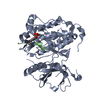 5czhC 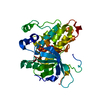 2itvS C: citing same article ( S: Starting model for refinement |
|---|---|
| Similar structure data |
- Links
Links
- Assembly
Assembly
| Deposited unit | 
| ||||||||
|---|---|---|---|---|---|---|---|---|---|
| 1 |
| ||||||||
| Unit cell |
|
- Components
Components
| #1: Protein |  / Proto-oncogene c-ErbB-1 / Receptor tyrosine-protein kinase erbB-1 / Proto-oncogene c-ErbB-1 / Receptor tyrosine-protein kinase erbB-1Mass: 37676.484 Da / Num. of mol.: 1 / Fragment: EGFR UNP RESIDUES 694-1022 / Mutation: YES Source method: isolated from a genetically manipulated source Source: (gene. exp.)   Homo sapiens (human) / Gene: EGFR, ERBB, ERBB1, HER1 / Production host: Homo sapiens (human) / Gene: EGFR, ERBB, ERBB1, HER1 / Production host:   Spodoptera frugiperda (fall armyworm) Spodoptera frugiperda (fall armyworm)References: UniProt: P00533,  receptor protein-tyrosine kinase receptor protein-tyrosine kinase |
|---|---|
| #2: Protein/peptide | Mass: 1279.184 Da / Num. of mol.: 1 / Fragment: SHC PEPTIDE UNP RESIDUES 345-353 / Source method: obtained synthetically Details: THE OPTIMIZED PEPTIDE WAS GENERATED BY LIBRARY SCREENING. Source: (synth.)   Escherichia coli H489 (bacteria) / References: UniProt: P29353*PLUS Escherichia coli H489 (bacteria) / References: UniProt: P29353*PLUS |
| #3: Water | ChemComp-HOH /  Water Water |
-Experimental details
-Experiment
| Experiment | Method:  X-RAY DIFFRACTION / Number of used crystals: 1 X-RAY DIFFRACTION / Number of used crystals: 1 |
|---|
- Sample preparation
Sample preparation
| Crystal | Density Matthews: 3.19 Å3/Da / Density % sol: 61.4 % |
|---|---|
Crystal grow | Temperature: 293 K / Method: vapor diffusion, hanging drop / pH: 7.6 Details: 0.1M HEPES 7.6, 0.15M NACL, 40% PEG400, 5MM TCEP, VAPOR DIFFUSION, HANGING DROP, TEMPERATURE 293K PH range: 7.6 |
-Data collection
| Diffraction | Mean temperature: 100 K |
|---|---|
| Diffraction source | Source:  SYNCHROTRON / Site: SYNCHROTRON / Site:  APS APS  / Beamline: 24-ID-E / Wavelength: 0.97925 Å / Beamline: 24-ID-E / Wavelength: 0.97925 Å |
| Detector | Type: ADSC QUANTUM 315 / Detector: CCD / Date: Apr 20, 2011 |
| Radiation | Monochromator: SI(220) / Protocol: SINGLE WAVELENGTH / Monochromatic (M) / Laue (L): M / Scattering type: x-ray |
| Radiation wavelength | Wavelength : 0.97925 Å / Relative weight: 1 : 0.97925 Å / Relative weight: 1 |
| Reflection | Resolution: 2.6→50 Å / Num. obs: 15212 / % possible obs: 99 % / Observed criterion σ(I): -3.3 / Redundancy: 3.4 % / Biso Wilson estimate: 68.3 Å2 / Rmerge(I) obs: 0.068 / Net I/σ(I): 13.8 |
| Reflection shell | Resolution: 2.6→2.69 Å / Redundancy: 3.1 % / Rmerge(I) obs: 0.447 / Mean I/σ(I) obs: 2.3 / % possible all: 99.5 |
- Processing
Processing
| Software |
| ||||||||||||||||||||||||||||||||||||||||||
|---|---|---|---|---|---|---|---|---|---|---|---|---|---|---|---|---|---|---|---|---|---|---|---|---|---|---|---|---|---|---|---|---|---|---|---|---|---|---|---|---|---|---|---|
| Refinement | Method to determine structure : :  FOURIER SYNTHESIS FOURIER SYNTHESISStarting model: 2ITV Resolution: 2.6→38.46 Å / SU ML: 0.32 / Cross valid method: FREE R-VALUE / σ(F): 0 / Phase error: 22.46 / Stereochemistry target values: ML
| ||||||||||||||||||||||||||||||||||||||||||
| Solvent computation | Shrinkage radii: 0.9 Å / VDW probe radii: 1.11 Å / Solvent model: FLAT BULK SOLVENT MODEL | ||||||||||||||||||||||||||||||||||||||||||
| Refinement step | Cycle: LAST / Resolution: 2.6→38.46 Å
| ||||||||||||||||||||||||||||||||||||||||||
| Refine LS restraints |
| ||||||||||||||||||||||||||||||||||||||||||
| LS refinement shell |
|
 Movie
Movie Controller
Controller



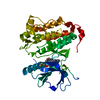
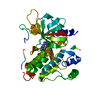
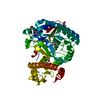
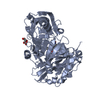
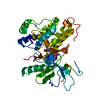
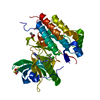
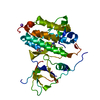

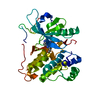

 PDBj
PDBj



























